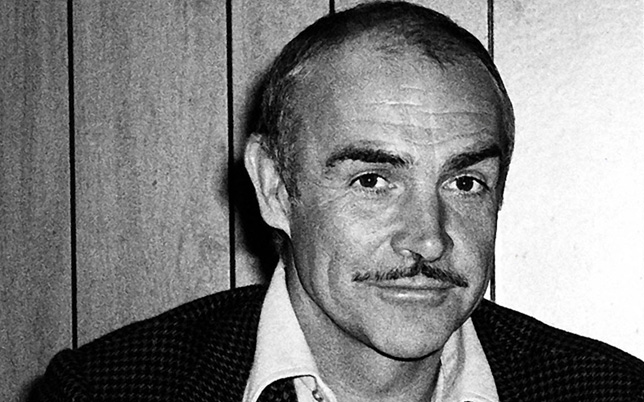
- Industry
Sean Connery
Thomas Sean Connery, born in Edinburgh, Scotland on August 25, 1930, was named Thomas after his paternal grandfather, nicknamed “Tommy” as a child, then “Big Tam” as a grown-up 6’2” athlete. Even after becoming the biggest movie star in the world with the success of the James Bond movies (1962-1971), he would remain proud of his humble beginnings on Fountainbridge Street, where he worked as a milk delivery boy on a horse drawn cart, in the mornings from age 9 and full-time from age 13, when he quit school during World War II. He joined the Royal Navy at 16, was discharged 3 years later because he suffered from ulcers; he held a variety of jobs and trained as a body-builder.
In 1953 at age 22, while in London to compete in the Mr. Universe contest, he was cast in the stage musical South Pacific and found a mentor in American actor/director Robert Henderson, who suggested him a list of books to read to further his education. During this national tour Connery chose to be an actor, over the offer of playing for Manchester United, even though he had been a passionate footballer since childhood, because acting would have offered him a longer career. Connery acted on stage and television, had his first film starring role in Another Time, Another Place (1958) with Lana Turner. On TV’s Anna Christie (1957) he had met Australian actress Diane Cilento, whom he would later marry (1962-1973); she suggested he study movement with Swedish dancer Yat Malgrem and learn to use his entire body in his acting. Director Terence Young wanted Connery as Secret Agent 007 in Dr. No (1962) from the 1958 novel by Ian Fleming; producers Harry Saltzman and Albert “Cubby” Broccoli approved after meeting the physically assertive actor. Connery would inject his sense of humor into the role and become a sex symbol of confident masculinity in the pre-feminist 1960s in 4 more Bond films, From Russia With Love (1963), his favorite, Goldfinger (1964), Thunderball (1965), You Only Live Once (1967). Then he quit and Bond was played by George Lazensby in Her Majesty’s Secret Service (1969). He was persuaded to return for one more film, Diamonds Are Forever (1971) for a higher fee ($1 million) and a percentage of the profits. It would be his second wife, the Moroccan Micheline, to convince him to play a middle-aged Bond in Never Say Never Again (1983), an alternative production released at the same time as Octopussy with Roger Moore as Bond.
Connery remains enshrined in popular culture as the definitive Bond, a role also played by Timothy Dalton, Pierce Brosnan and Daniel Craig. Connery said to the journalists of the Hollywood Foreign Press in 1976: “I like to find the humor in every character. It’s my own personal touch, because I feel that it’s much more revealing than the obvious tirade or the gloom and the melodramatics.” And in 1983: “The reasons for me going from the Bond films are quite a few and inter-related; primarily it was all the demand on my time, so I could never plan any projected films in the future. There was a constant conflict between the producers and myself about the monetary return, which was never really resolved until I came back for Diamonds. When the films got more involved with special effects and gadgetry, I consequently rebelled against that.”
Connery had acted in several films during his Bond years, Marnie (1964) by Alfred Hitchcock with Tippi Hedren, The Hill (1965) by Sidney Lumet, A Fine Madness (1966) by Irvin Kershner with Joanne Woodward, and expanded his range in the 1970s in Zardoz (1974) by John Boorman with Charlotte Rampling, The Wind and the Lion (1975) by John Milius with Candice Bergen, The Man Who Would Be King (1975) by John Huston with his life-long friend Michael Caine, Robin and Marian (1976) by Richard Lester with Audrey Hepburn. The father of a son, Jason, born in 1963, in the 1980s Connery transitioned to father/mentor roles in Time Bandits (1981) by Terry Gilliam, The Name of the Rose (1986) directed by Jean-Jacques Annaud from the novel by Umberto Eco with Christian Slater, The Untouchables (1987) by Brian De Palma with Kevin Costner, Presidio (1988) by Peter Hyams with Meg Ryan, Family Business (1989) by Sidney Lumet with Dustin Hoffman, Indiana Jones and the Last Crusade (1989) by Steven Spielberg with Harrison Ford, Hunt for Red October (1990) by John McTiernan with Alec Baldwin. He said to HFPA in 1989: “It’s strange that I suddenly find myself playing the father figures, or the monk teaching the young novice, but I rather like that. I guess we’re still looking for some kind of guide to be our big daddy and make decisions for us, because it appears to get more and more difficult every day.” Connery continued to play romantic leads into the 1990s, in Russia House (1990) by Fred Schepisi with Michelle Pfeiffer, First Knight (1995) as King Arthur with Julia Ormond and Richard Gere, Entrapment (1999) by Jon Amiel with Catherine Zeta- Jones. He played another mentor in Finding Forrester (2000) by Gus Van Sant (2000), and retired in 2003 after The League of Extraordinary Gentlemen. In 2008 he published a book about Scottish history and culture, Being a Scot. In 1971 he had founded the Scottish International Education Trust to support talented Scots in any field.
Connery left the UK in 1974, when his tax rate was raised to 98%, and moved to Marbella Spain, then to the Bahamas in 1989. The Hollywood Foreign Press honored Sean Connery with a Cecil B. deMille Award in 1996, with a Henrietta award as World Film Favorite in 1972, with a Golden Globe as best Supporting actor for The Untouchables in 1988, and a nomination for Indiana Jones and the Last Crusade in 1990.